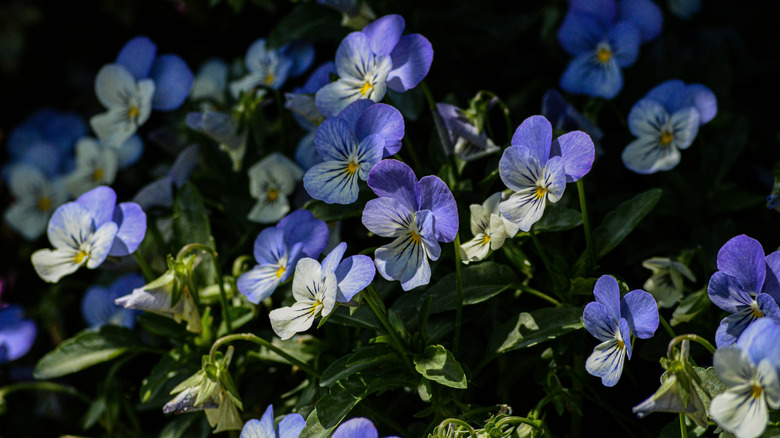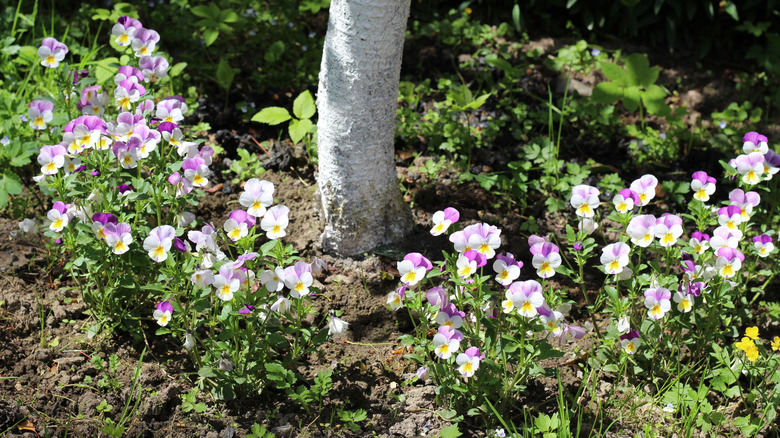Mistakes Everyone Makes When Growing Horned Violets As A Ground Cover
Ground covers play an important role in gardens. Not only do they help stabilize soil and suppress weeds, but they can be a beautiful addition to your yard. In some cases, they can even replace mulch, which can present cost-savings in the long run. People looking for a low maintenance ground cover that blankets the area with flowers often turn to the gorgeous grass alternatives — horned violets (Viola cornuta). Hardy in Zones 6 through 11, these flowers can be an excellent choice for brightening up your yard. However, if you want to use them as a ground cover — and are expecting a year-round flush of blooms — there are a few potential mistakes and false expectations you should be aware of before planting them.
For instance, horned violets may not be suitable for your yard if you experience hot temperatures often. Likewise, don't make the mistake of thinking that their blooms will stay on all summer long, or that planting horned violets will quickly get you a lush carpet of weed-free blooms. If you decide to grow this ground cover, avoid the mistake of leaving it vulnerable to various pests. Let's explore these common mistakes in greater detail and learn how to grow and care for these useful and beautiful flowers properly.
Common mistakes and misconceptions when growing horned violets
One common mistake people make is expecting horned violets to bloom throughout the summer. Once the heat kicks in, the blooms on horned violets will die back, as they bloom better in cool weather. So, if you are expecting blooms through the height of the summer, this may not be the right ground cover for you. Additionally, if you live in a region with extreme heat, you may want to keep looking for a ground cover that thrives in harsh sun. Despite their preference for lower temperatures, these flowers need a good deal of indirect sunlight to bloom. So, don't expect many flowers if you plant horned violets in an area with deep shade.
Ground covers are known to suppress weeds, but don't make the mistake of expecting a weed-free garden once you plant horned violets. You'll have to weed around the young plantings until they are well established. If you're looking for a plant that spreads rapidly and out-competes all the other plants in its way, horned violets may not be right for you.
While horned violets are deer resistant, they do have some known pests, so don't make the error of leaving them completely unprotected. Keep an eye out for slugs, snails, and other creatures that have an appetite for this plant. Apart from pests, this ground cover can be plagued by powdery mildew and pansy leaf spot.
How to grow horned violets
Horned violets can grow in sun or part shade and require moist but well-drained soil. This makes them an especially good choice for slightly shady areas where other groundcovers may have a tough time taking hold. Though horned violets are not native to the United States and spread by rhizomes, there are no states where they are considered invasive. The rhizomes also mean you can split these hardy plants to propagate more.
Plant in early spring to bring a bit of color to the early garden (they can even handle a bit of snow or frost). Water only when the soil is slightly dry, as root rot can be a concern. Trim them in as summer weather sets in to promote new growth and possibly reblooming when the temperatures dip in the fall.
Consider using a vinegar solution to control slugs and snails, and note that vinegar can also be effective against powdery mildew. When planting horned violets in full sun, mulch the soil around horned violets to keep the growing medium cooler. Mix a slow release fertilizer into the soil in spring and late summer to help promote fall flowers.


